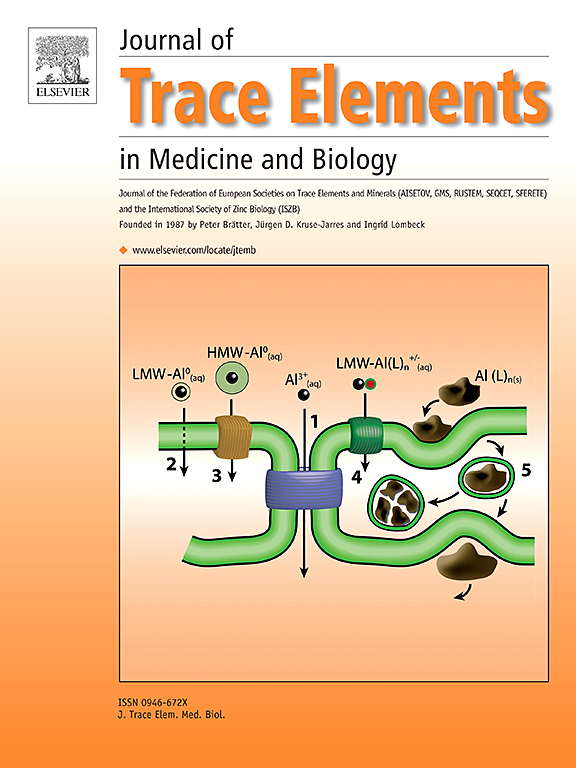Trace lithium concentrations in mental disorders and suicidal behavior: A cross-sectional study
IF 3.6
3区 医学
Q2 BIOCHEMISTRY & MOLECULAR BIOLOGY
Journal of Trace Elements in Medicine and Biology
Pub Date : 2025-02-14
DOI:10.1016/j.jtemb.2025.127621
引用次数: 0
Abstract
Background
Studies have demonstrated a negative correlation between lithium trace concentrations in drinking water and suicide rates; however, a study focused on clinical significance of lithium concentrations in individual patients was needed. Therefore, we aimed to assess lithium trace concentrations in individuals with mental disorders and compare them to healthy controls to evaluate whether lithium concentrations are associated with mental disorders and/or suicidal behavior.
Method
We enrolled 50 patients diagnosed with mental disorders without a history of suicidal behavior, 51 patients hospitalized after a suicidal attempt, and 46 healthy individuals as a control group for the analysis and comparison of lithium trace concentrations in blood serum. The suicidality risk was evaluated using the Mini International Neuropsychiatric Interview. Quantile regression (QR) was used to evaluate lithium concentrations (as the outcome) between the control and patient groups (as predictors), along with a set of covariates.
Results
The median of serum lithium concentration overall was 1.76 µg/L (IQR 1.17–3.42); range 0.2–26.95 µg/L. Mutivariable QR analysis, adjusted for age, gender, and suicidality risk, revealed that at the 75th quantile, in patients' lithium concentrations were significantly lower compared to the controls. A high suicidality risk was associated with decreased lithium concentrations at the 75th quantile (B = − 2.073, p = 0.014).
Conclusion
The serum lithium concentrations in the highest quantiles were significantly lower in patients with mental disorders compared to healthy individuals and lower lithium concentrations in serum were associated with a higher risk of suicidality.
微量锂浓度对精神障碍和自杀行为的影响:一项横断面研究
研究表明,饮用水中微量锂浓度与自杀率呈负相关;然而,需要对个别患者锂浓度的临床意义进行研究。因此,我们旨在评估精神障碍患者的微量锂浓度,并将其与健康对照进行比较,以评估锂浓度是否与精神障碍和/或自杀行为有关。方法选取50例无自杀史的精神障碍患者、51例自杀未遂住院患者和46例健康人群作为对照组,分析比较其血清中微量锂浓度。使用迷你国际神经精神病学访谈评估自杀风险。分位数回归(QR)用于评估对照组和患者组(作为预测因子)之间的锂浓度(作为结果),以及一组协变量。结果血清锂离子总体浓度中位数为1.76 µg/L (IQR 1.17 ~ 3.42);范围0.2 - -26.95 µg / L。校正了年龄、性别和自杀风险的多变量QR分析显示,在第75分位数,患者的锂浓度明显低于对照组。高自杀风险与第75分位数的锂浓度降低相关(B =−2.073,p = 0.014)。结论精神障碍患者血清最高分位数的锂离子浓度显著低于健康人群,低锂离子浓度与较高的自杀风险相关。
本文章由计算机程序翻译,如有差异,请以英文原文为准。
求助全文
约1分钟内获得全文
求助全文
来源期刊
CiteScore
6.60
自引率
2.90%
发文量
202
审稿时长
85 days
期刊介绍:
The journal provides the reader with a thorough description of theoretical and applied aspects of trace elements in medicine and biology and is devoted to the advancement of scientific knowledge about trace elements and trace element species. Trace elements play essential roles in the maintenance of physiological processes. During the last decades there has been a great deal of scientific investigation about the function and binding of trace elements. The Journal of Trace Elements in Medicine and Biology focuses on the description and dissemination of scientific results concerning the role of trace elements with respect to their mode of action in health and disease and nutritional importance. Progress in the knowledge of the biological role of trace elements depends, however, on advances in trace elements chemistry. Thus the Journal of Trace Elements in Medicine and Biology will include only those papers that base their results on proven analytical methods.
Also, we only publish those articles in which the quality assurance regarding the execution of experiments and achievement of results is guaranteed.

 求助内容:
求助内容: 应助结果提醒方式:
应助结果提醒方式:


